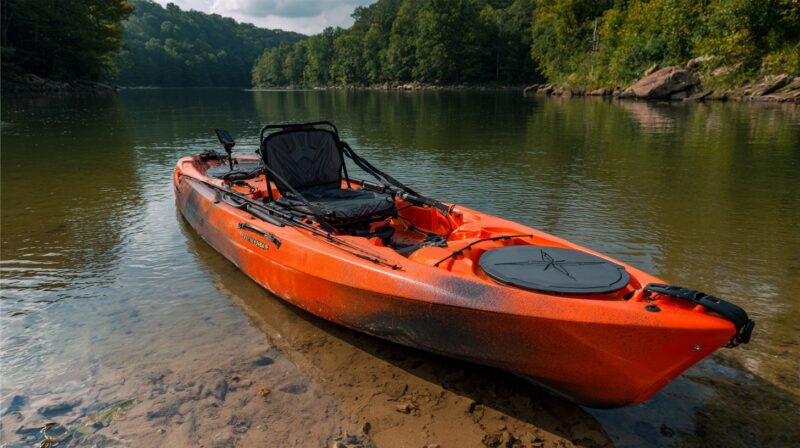Choosing the ideal fishing kayak can be a daunting task, especially with the numerous options available in the market. For anglers who frequent lakes, a kayak that offers stability, comfort, and the right features is crucial for a successful fishing trip.
Today’s fishing kayaks are designed to provide a sturdy and balanced platform, allowing anglers to access water that other boats can’t. With various features and options available, selecting the right kayak can be overwhelming.
This comprehensive guide will help you navigate the process, covering critical aspects such as stability, propulsion options, and comfort features that enhance your lake fishing adventures.
Key Takeaways
- Understand the essential features that make a fishing kayak suitable for lake environments.
- Learn about different hull designs and their impact on performance.
- Discover top-rated fishing kayaks across various categories and price points.
- Explore critical aspects like stability and comfort features.
- Make an informed purchase decision based on your specific needs and budget.
Lake Fishing Kayaks 101
Fishing kayaks have become increasingly popular among anglers due to their versatility and effectiveness on lakes. With numerous options available, anglers can now choose from a variety of kayaks that cater to their specific fishing needs.
Why Fishing Kayaks Are Ideal for Lake Fishing
Fishing kayaks are particularly well-suited for lake fishing due to their design and functionality. According to a seasoned angler, “Fishing kayaks offer a unique combination of stability and maneuverability that is hard to find in other types of watercraft.”
They provide anglers with the ability to access areas that larger boats cannot, making them ideal for exploring lakes and catching fish in tight spaces.
Lake fishing kayaks typically feature wider hulls, which provide greater primary stability. This stability is crucial for fishing in open lake waters, where anglers often need to stand or move around. The design of these kayaks emphasizes tracking ability, allowing anglers to maintain straight lines when covering distance across the water.
How Lake Fishing Kayaks Differ from Other Kayak Types
Lake fishing kayaks differ significantly from other types of kayaks, such as recreational, touring, or whitewater kayaks. Unlike whitewater kayaks, which prioritize maneuverability, lake fishing kayaks focus on stability and tracking performance.
As noted by experts, lake fishing kayaks incorporate specialized features like rod holders, tackle storage, and fish finder mounts, making them more functional for fishing.
The seating systems in lake fishing kayaks are designed for comfort during extended fishing sessions. Elevated seating positions provide better visibility and casting angles, enhancing the overall fishing experience. Additionally, lake fishing kayaks often have flatter hull designs compared to ocean kayaks, which increases stability for standing and casting.
Key Features to Look for in a Fishing Kayak for Lake
To maximize the potential of a fishing trip on a lake, it’s essential to understand the critical features that distinguish a good fishing kayak from a great one. A fishing kayak designed for lake use must balance several key elements to provide both comfort and functionality during extended fishing sessions.
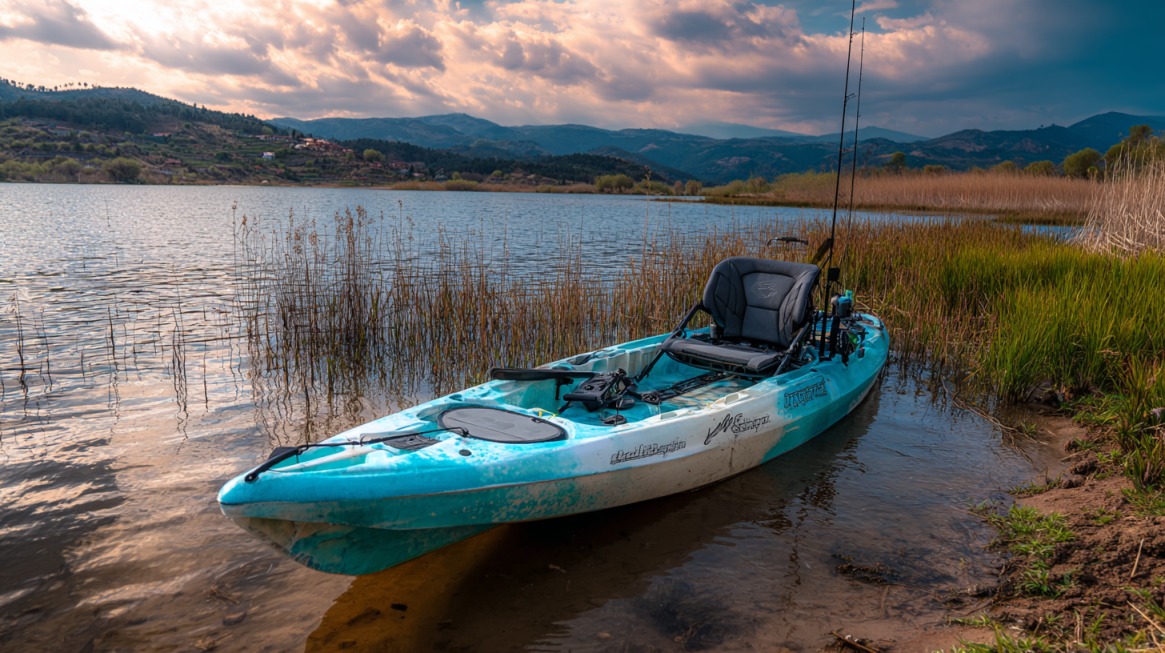
Stability vs. Speed: Finding the Right Balance
When it comes to lake fishing, the stability of a kayak is often more crucial than its speed. A stable kayak allows anglers to stand, cast, and maneuver with ease, reducing the likelihood of capsizing.
However, speed can be a consideration for those who need to cover larger distances or reach specific fishing spots quickly. The ideal kayak strikes a balance between these two factors, offering enough stability for comfortable fishing and sufficient speed to navigate the lake efficiently.
Weight Capacity and Storage Options
The weight capacity of a fishing kayak is a critical factor, as it determines how much gear you can safely carry. Lake fishing often requires a variety of equipment, including rods, tackle, and personal items.
A kayak with ample storage options, such as compartments and bungee systems, helps keep gear organized and within reach. Look for kayaks with adjustable storage solutions to accommodate your specific needs.
Comfort Features for Long Fishing Sessions
Comfort is paramount during long fishing sessions on lakes. A quality seat is perhaps the most important comfort feature, with the best models offering adjustable back support, breathable materials, and cushioning. The premium seat in certain kayaks, like Feelfree’s Gravity seats, is unmatched for comfort under $1,000.
Additionally, consider kayaks with adjustable foot braces or pegs, standing platforms with non-slip padding, and scupper plugs to enhance overall comfort during your fishing trip.
Other comfort features to look for include ergonomic design elements such as accessible rod holders, paddle holders, and drink holders that minimize awkward reaching or twisting movements. These features contribute to a more enjoyable and less fatiguing fishing experience.
Hull Design and Its Impact on Performance
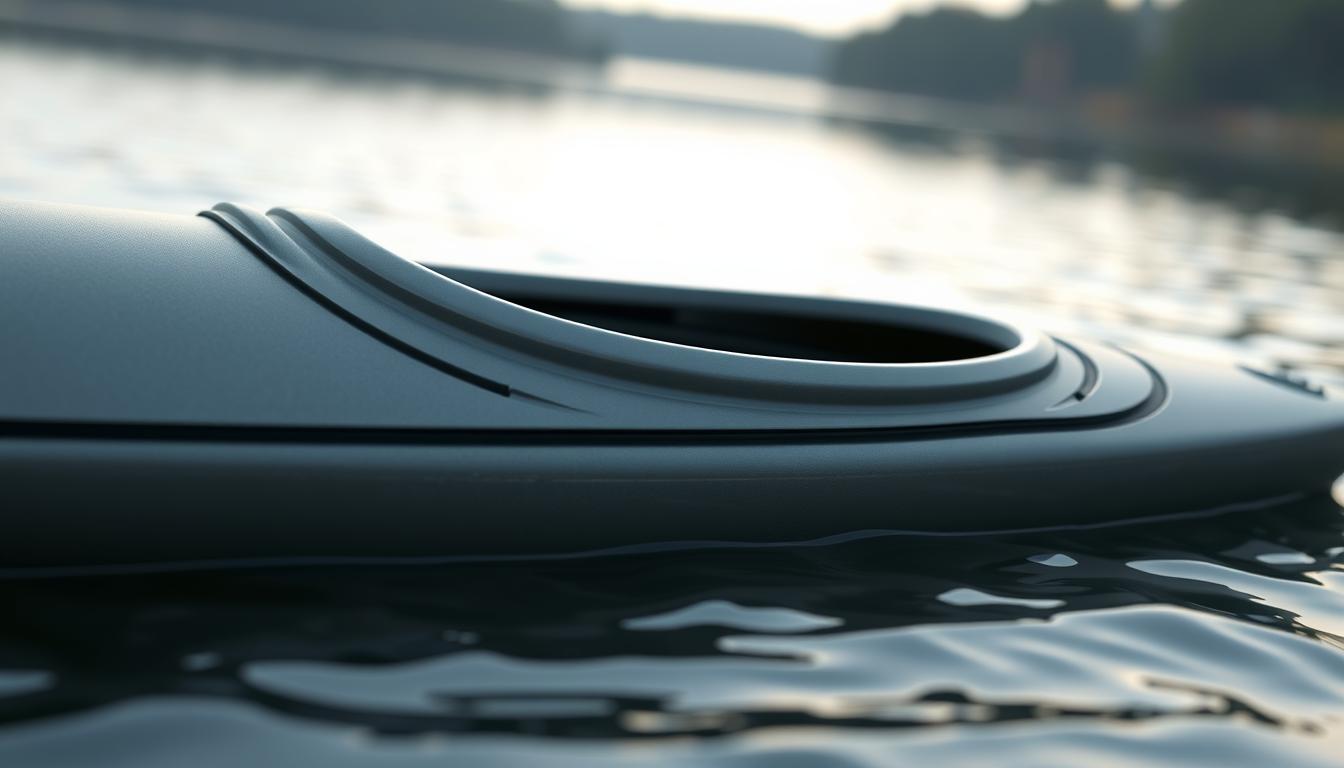
Understanding the different hull designs available for fishing kayaks is essential for optimizing performance on lake waters. The hull design of a fishing kayak significantly influences its stability, speed, and maneuverability.
Flat vs. V-Shaped Hulls for Lake Conditions
Flat hulls are known for their stability, making them ideal for calm lake waters where anglers often stand to fish. They provide a stable platform but can be less efficient in terms of speed and tracking compared to V-shaped hulls.
V-shaped hulls, on the other hand, are designed for better tracking and speed. They cut through the water more efficiently, making them suitable for lakes with choppy conditions or for anglers who need to cover more distance.
Tunnel and Pontoon Hull Designs
Tunnel hull designs create channels on the bottom of the kayak that enhance stability by trapping air and water, providing a more stable platform. This design is particularly beneficial for lake fishing, where calm waters allow anglers to take advantage of the increased stability.
- Pontoon (or catamaran) hull designs feature two parallel pontoons that create exceptional stability, making them ideal for anglers who prioritize standing and casting on lakes.
- These specialized hull designs often create a “tri-hull” effect that combines the stability benefits of multiple hull types while minimizing their individual drawbacks.
- The increased stability of tunnel and pontoon hulls makes them excellent choices for fishing electronics installation, as they provide a steady platform that reduces false readings from excessive movement.
While these hull designs excel in stability, they typically create more drag in the water, resulting in reduced speed and requiring more effort to paddle over long distances compared to traditional V-hulls.
Propulsion Options: Paddle, Pedal, or Motor
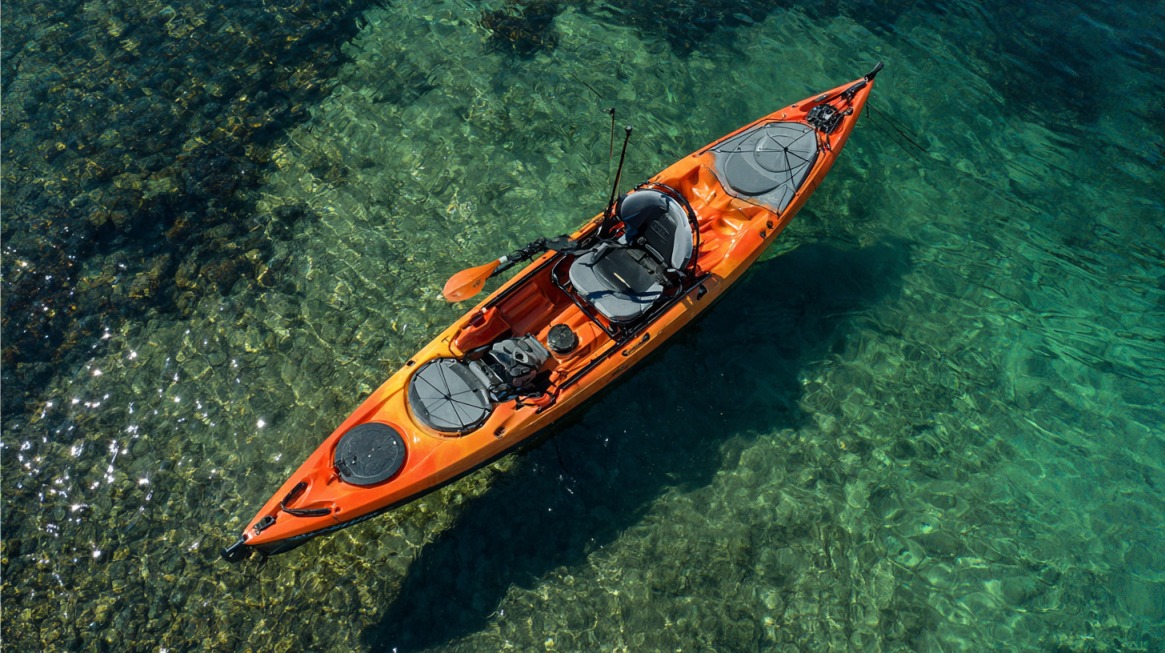
The propulsion system of a fishing kayak is a critical factor that determines its performance and efficiency on the water. Anglers have three primary options to choose from: traditional paddle, pedal-driven, and motorized systems. Each has its advantages and is suited to different fishing styles and preferences.
Traditional Paddle Kayaks
Traditional paddle kayaks are the most straightforward and cost-effective option. They provide a great workout and allow anglers to stay connected to the water and their surroundings. Paddling is quiet and doesn’t disturb the fish, making it an excellent choice for those who prefer a more traditional fishing experience.
The simplicity of paddle kayaks means fewer mechanical parts to worry about, reducing the risk of equipment failure. However, paddling can be tiring, especially over long distances or in windy conditions.
Pedal-Driven Systems
Pedal-driven kayaks have gained popularity among anglers due to their ability to free up hands for fishing while maintaining propulsion. Systems like Old Town’s Predator PDL offer efficient and fatigue-free navigation. Pedal kayaks allow anglers to cover more water with less effort, making them ideal for larger lakes and reservoirs.
The Old Town BigWater ePDL is a notable example, offering the versatility of pedal, pedal-assist, and full auto modes. This hybrid system provides anglers with the flexibility to adapt to different fishing conditions.
Motorized Options for Covering More Water
Motorized fishing kayaks represent the fastest-growing segment in the market, offering unparalleled efficiency for covering large bodies of water with minimal physical effort. Modern electric motors come in various configurations, including bow-mounted trolling motors and integrated systems.
Battery life is a critical consideration, with most systems providing 4-8 hours of continuous use. The added weight of motors and batteries increases the overall weight of the kayak, requiring consideration for transportation and launching. Hybrid systems like Old Town’s ePDL technology combine pedal and motor power, offering versatility for different conditions.
Seating Systems and Comfort Considerations
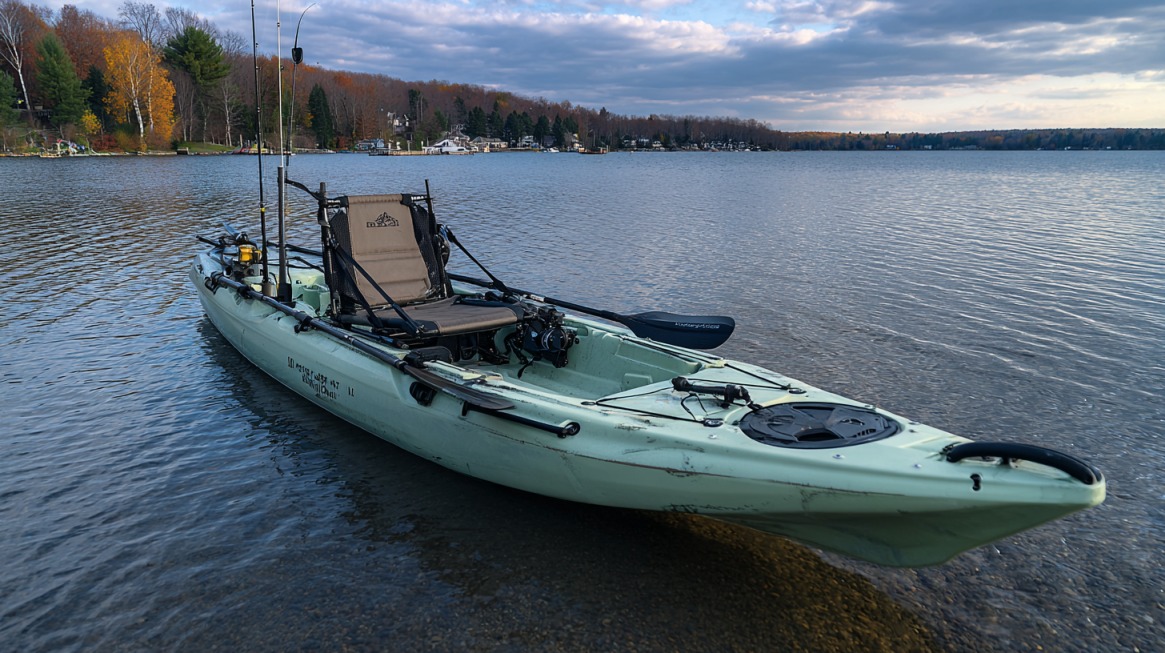
A well-designed seating system is essential for anglers who spend long hours fishing from their kayaks. Comfort and support are crucial for enjoying extended periods on the lake, and a good seating arrangement can significantly enhance the overall fishing experience.
Elevated vs. Low-Profile Seats
The debate between elevated and low-profile seats in fishing kayaks centers around visibility, comfort, and stability. Elevated seats offer better visibility over the kayak’s bow, potentially improving the angler’s ability to spot fish.
For instance, the Hobie Mirage Outback features an adjustable seat back and bottom with lumbar support, demonstrating the importance of adjustability in seating systems. On the other hand, low-profile seats can lower the center of gravity, enhancing stability in rough waters.
When choosing between these options, anglers should consider their typical fishing conditions and personal preferences. Some kayaks offer adjustable or interchangeable seating options, providing flexibility for different fishing environments.
Adjustability Features for All-Day Comfort
Modern fishing kayak seats often incorporate various adjustability features to ensure all-day comfort. Multi-point adjustability allows anglers to fine-tune their seating position throughout the day, preventing discomfort during long fishing sessions.
Key features include lumbar support, breathable mesh materials, and adjustable leg positions through movable foot braces.
- Lumbar support features have become standard in higher-end fishing kayaks, addressing back fatigue during extended periods of sitting.
- Breathable mesh materials enhance comfort in warm weather by allowing airflow and reducing heat buildup.
- The ability to adjust leg position helps prevent lower body fatigue and cramping during long days on the water.
- Some advanced seating systems include tension adjustment features, allowing anglers to customize the firmness of the seat back and bottom according to their preferences and body type.
By adjusting the backrest and seat bottom to support their lower back and legs, anglers can significantly improve their comfort during fishing trips. As seen in the Hobie Mirage Outback, adjustable seating with lumbar support is a valuable feature for enhancing the fishing experience.
Storage and Rod Management Solutions
A well-designed fishing kayak with adequate storage and rod management solutions is vital for serious anglers. When venturing onto the lake, having your gear organized and within reach can significantly enhance your fishing experience.
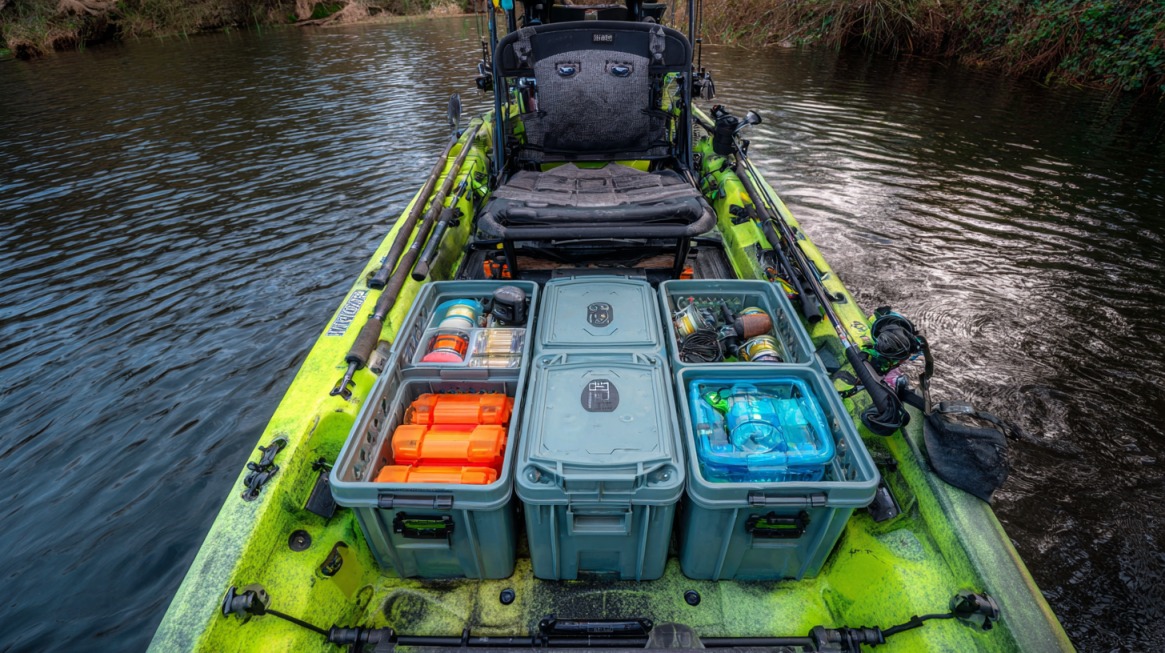
Rod Holders and Their Placement
Rod holders are a critical feature in a fishing kayak, allowing anglers to secure their rods while navigating or when fish are not actively biting. The placement of these holders is crucial for maintaining balance and ensuring easy access.
Typically, fishing kayaks come equipped with multiple rod holders positioned on the sides or rear of the kayak. The Wilderness Systems Tarpon120, for example, features adjustable rod holders that can be customized to fit different rod sizes and styles.
Tackle Storage Options
Tackle storage is another essential aspect of a fishing kayak’s design. Anglers need a variety of compartments and trays to organize their lures, hooks, and other tackle. Modern fishing kayaks often include dedicated tackle storage areas that are easily accessible from the seating position.
For instance, some kayaks feature removable tackle boxes that can be taken ashore, ensuring that your gear remains organized throughout your fishing trip.
Dry Storage for Electronics and Valuables
Dry storage is vital for protecting electronics and valuables from water exposure. Many fishing kayaks now come with waterproof hatches and dry boxes to keep items such as phones, keys, and cameras dry. The Tarpon’s DryTec Case is an example of an integrated dry box that safely stores valuables.
Additionally, dedicated battery compartments and electronics pods simplify the installation of fish finders and other electronic devices, keeping connections protected from water.
When selecting a fishing kayak, consider the size and accessibility of dry storage compartments based on your specific needs. Photographers may require larger waterproof storage for camera gear, while tournament anglers might prioritize space for multiple electronics.
Size and Weight Considerations
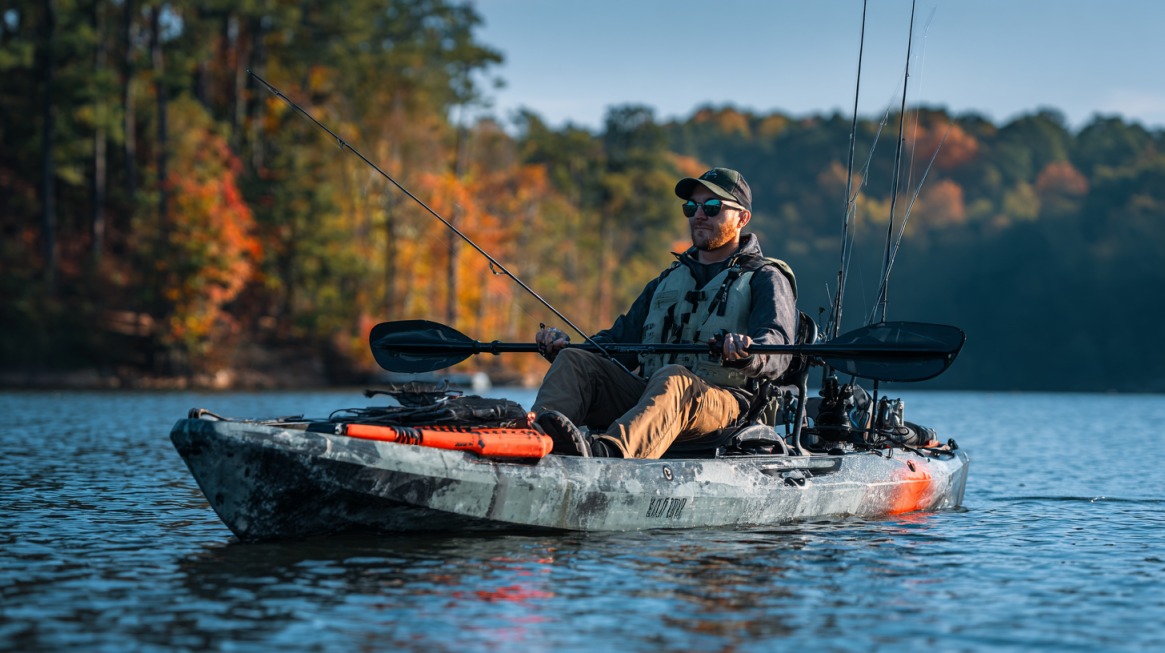
The dimensions and weight of a fishing kayak play a pivotal role in determining its suitability for lake fishing, affecting everything from stability to storage.
When choosing a fishing kayak, it’s essential to balance size and weight with your specific needs, including the type of fishing you’ll be doing, your physical abilities, and how you plan to transport the kayak.
Length and Width Tradeoffs
The length and width of a fishing kayak are critical factors that influence its performance on the water. Longer kayaks tend to track better and offer more speed, while shorter kayaks provide greater maneuverability.
For instance, the Bonafide P127, weighing 129 lbs with a capacity of 425 lbs, is designed for stability and performance. In contrast, the Sea Eagle FastTrack Angler, weighing just 45 lbs with a capacity of 635 lbs, offers exceptional portability at the expense of some performance.
When considering length and width, it’s also important to think about the type of fishing you’ll be doing. For open lake fishing, a longer, narrower kayak might be preferable for its speed and tracking ability.
- Kayak weight varies significantly between models and propulsion types, ranging from 50-70 pounds for basic paddle kayaks, 80-120 pounds for pedal kayaks, and potentially exceeding 150 pounds for motorized options.
- The weight capacity of kayaks also varies, with some models like the Sea Eagle FastTrack Angler offering capacities of up to 635 lbs.
Transportation and Portability Factors
Transportation and portability are crucial considerations when selecting a fishing kayak. The weight of the kayak is a significant factor, as it affects how easily it can be moved from your vehicle to the water. Features such as molded handles, grab points, and wheel systems can greatly enhance portability, especially for solo anglers.
The method of transportation also significantly influences kayak selection. For those using roof rack transport, lighter models under 80 pounds may be more suitable. In contrast, trailer transport allows for the consideration of heavier, feature-rich options.
- Portability features such as molded handles and wheel systems can improve the ease of moving a kayak.
- Inflatable kayaks provide exceptional portability, albeit with some performance limitations compared to hard-shell models.
Top Pedal Fishing Kayaks for Lakes
@wesklittlefield Top Kayak Fishing Brands I’d buy from in 2025 if I was searching for a new kayak #KayakFishing #Fishing #BestKayakBrands ♬ original sound – Wes Littlefield
The top pedal fishing kayaks for lakes offer anglers a unique combination of maneuverability and stealth. For those looking to explore the best options, several models stand out for their performance, features, and overall value.
Hobie Mirage Outback
The Hobie Mirage Outback is a popular choice among anglers due to its reliable MirageDrive 180 pedal system and spacious cockpit. With a length of 12 feet and a weight of 86 pounds, it’s designed for efficiency and maneuverability.
The Outback features a large storage hatch and multiple rod holders, making it ideal for long fishing trips.
The Flip-Kat®
The Flip-Kat® from Noisy River Outdoors is an innovative collapsible pedal fishing kayak designed for anglers who need portability without sacrificing performance. Featuring a patented folding catamaran hull, it combines impressive stability with a compact footprint, making it ideal for lake fishing in tight spaces or urban environments.
When deployed, the Flip-Kat® measures 11′3″ long with a 4-foot-wide deck, providing excellent stability for stand-up casting or sight fishing. Its integrated belt-driven pedal system operates quietly and features an auto kick-up propeller for navigating shallow waters safely.
The kayak folds down to just 53″ × 23″ × 27″, fitting easily into SUVs, closets, or elevators. An all-in-one adjustable seat and leaning post offers multiple height and backrest positions for comfort during long fishing trips. With waterproof hull storage, T-tracks for mounting accessories, and a quick two-minute setup, the Flip-Kat® is a versatile choice for anglers seeking convenience and top-tier features.
Old Town Sportsman BigWater PDL132
The Old Town Sportsman BigWater PDL132 is a high-performance pedal kayak designed for serious anglers. It features a PDL Drive system that allows for hands-free fishing and easy maneuverability.
With a length of 13.2 feet and a capacity of 500 pounds, it’s suitable for larger anglers and gear. The BigWater PDL132 also includes multiple storage compartments and rod holders.
Bonafide P127
The Bonafide P127 is a premium pedal kayak that combines Native Watercraft’s Propel pedal drive system with Bonafide’s renowned hull design. At 12’7″ long and 34 inches wide, it offers excellent stability for stand-up fishing while maintaining good tracking and speed.
The P127 features an extra-wide comfortable seat, under-seat gear drawer, removable bow hatch, and durable aluminum gear tracks. With a capacity of 425 pounds and a weight of 129 pounds, it’s designed for serious anglers who prioritize features and performance.
Best Motorized Fishing Kayaks for Lake Excursions
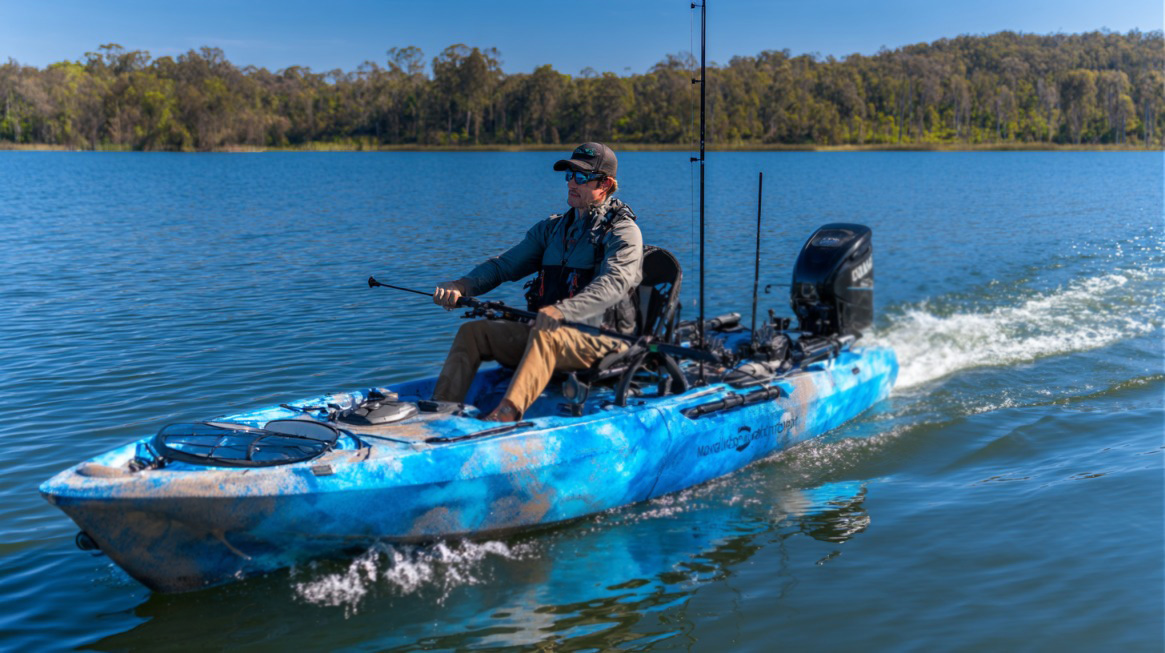
Exploring lakes with a motorized fishing kayak allows anglers to access a wider range of fishing spots. Motorized kayaks provide the power and efficiency needed to cover more water, making them an ideal choice for lake excursions.
Old Town BigWater ePDL
The Old Town BigWater ePDL is a top choice for anglers seeking a motorized fishing kayak. It features a reliable electric propulsion system, offering a quiet and efficient way to navigate lakes.
Old Town Sportsman AutoPilot
The Old Town Sportsman AutoPilot is another excellent option, equipped with advanced technology for precise control and navigation. Its motorized system allows for hands-free operation, making it perfect for anglers.
Jackson Knarr FD
The Jackson Knarr FD is designed for tournament competition, featuring a hull that balances speed, tracking, and exceptional stability. While primarily a pedal kayak, it is designed with integrated motor mounting options for easy addition of electric outboard or trolling motors.
- The Jackson Knarr FD combines tournament-tested design with motor-ready capabilities.
- The unique Flex Drive system provides propulsion and contributes to stability.
- The kayak includes three-sided gear tracks for extensive accessory mounting.
These motorized fishing kayaks offer a range of features and benefits for lake excursions. Whether you’re a competitive angler or a recreational fisherman, there’s a kayak on the market designed to meet your needs.
Top Traditional Paddle Fishing Kayaks
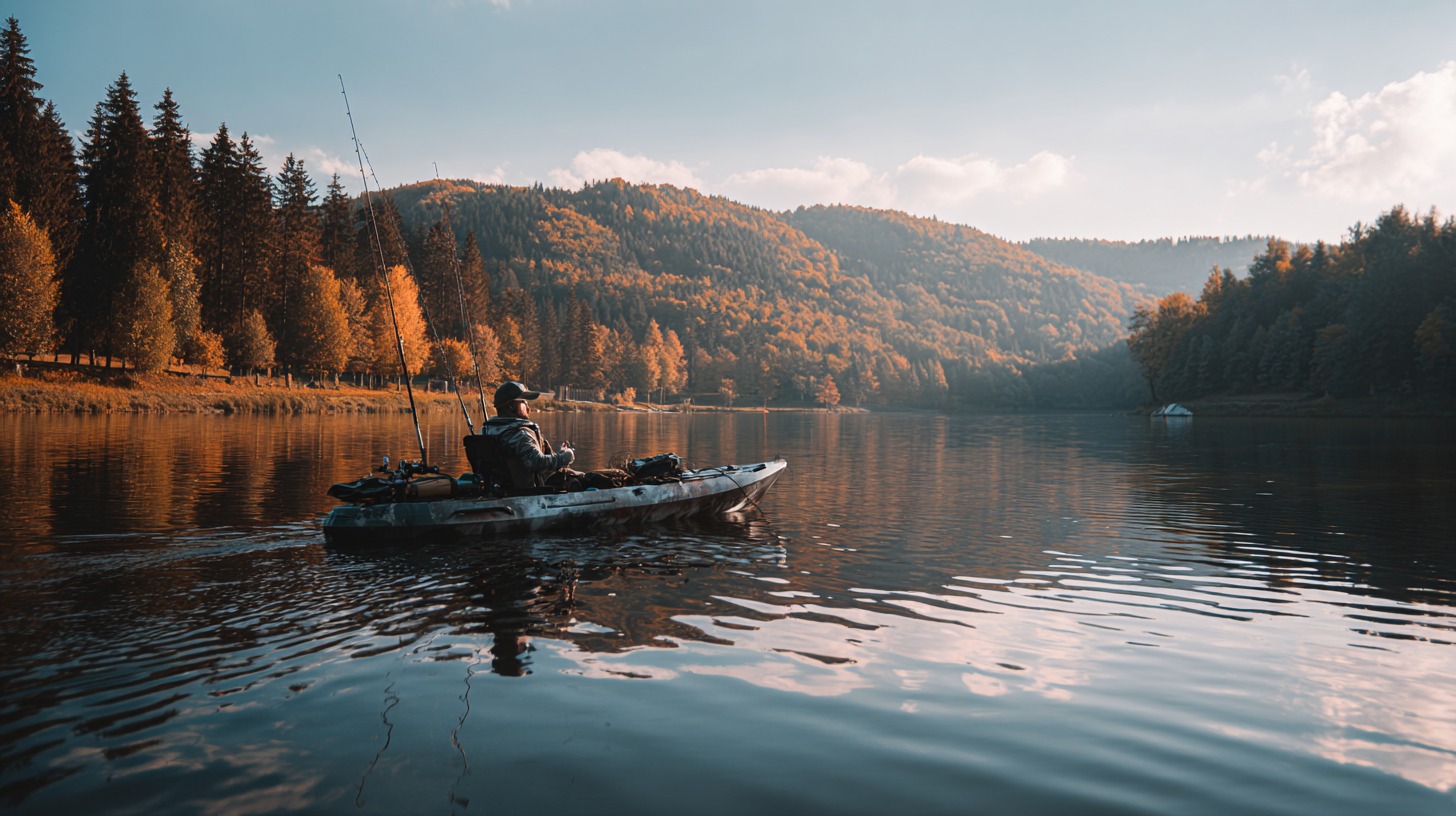
Traditional paddle fishing kayaks remain a favorite among anglers for their simplicity and effectiveness on calm waters. These kayaks offer an intimate fishing experience, allowing anglers to navigate through serene lake environments with ease.
Wilderness Systems Tarpon120
The Wilderness Systems Tarpon120 is a versatile and feature-rich paddle fishing kayak designed for lakes and other calm waters. It boasts a comfortable seating system and ample storage for gear, making it ideal for day-long fishing excursions.
With its stable and maneuverable design, the Tarpon120 allows anglers to focus on fishing rather than worrying about their kayak. It features multiple rod holders and accessory tracks, providing the flexibility to customize the kayak to your fishing needs.
Perception Pescador Pro10.0
The Perception Pescador Pro10.0 is a compact and highly portable paddle fishing kayak that is ready to fish right out of the box. It features spacious open storage, covered dry storage, and two rod holders, along with multiple gear tracks for easy accessory mounting.
At just 10’6″ long and weighing 52 pounds, the Pescador Pro10.0 is exceptionally easy to transport, store, and handle solo. Despite its compact size, it provides good stability with a 32-inch width, making it suitable for anglers who value simplicity and convenience.
Both the Wilderness Systems Tarpon120 and Perception Pescador Pro10.0 offer excellent performance and features for paddle fishing on lakes. They represent top choices for anglers seeking traditional paddle fishing kayaks that are both effective and enjoyable to use.
Budget-Friendly Fishing Kayaks for Lakes
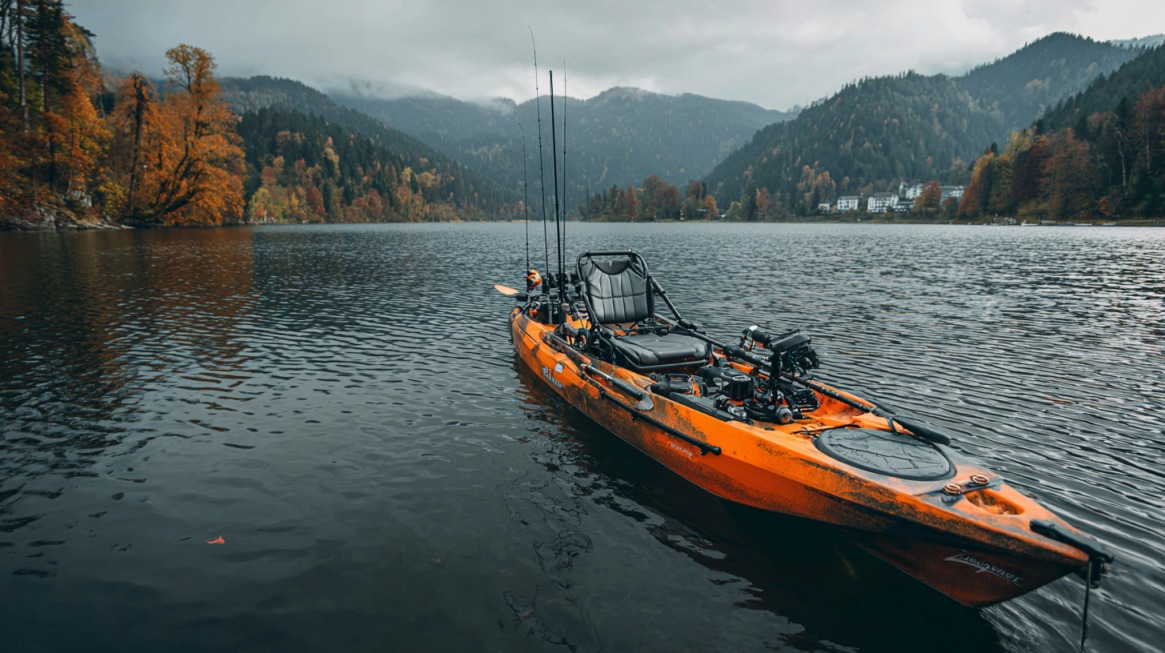
Budget-friendly fishing kayaks are making lake fishing accessible to everyone. For anglers who don’t want to spend a fortune on equipment, there are several options available that offer great value for money.
When looking for an affordable fishing kayak, it’s essential to consider factors like stability, weight capacity, and storage options.
Ascend133X
The Ascend133X is a highly-regarded, budget-friendly fishing kayak that offers excellent performance and features. With its robust design and ample storage, it’s ideal for lake fishing excursions. The Ascend133X boasts a weight capacity of 350 lbs, making it suitable for most anglers.
Pelican Catch Classic100
The Pelican Catch Classic100 is another affordable option that’s perfect for lake fishing. Its tunnel hull design provides exceptional stability, allowing anglers to stand and fish comfortably. The kayak features rod holders, tackle storage, and an adjustable seat, making it a complete fishing platform.
- The Pelican Catch Classic100 represents one of the best values in stand-up fishing kayaks, featuring a tunnel hull design that provides exceptional stability at an affordable price point.
- At just 10 feet long and 57 pounds, the Catch Classic100 is exceptionally portable and manageable for solo anglers.
- The 34-inch width and tunnel hull design create a stable platform that allows for comfortable stand-up fishing.
- With a 350-pound capacity, the kayak accommodates most anglers and basic fishing gear.
- The Catch100 includes essential fishing features like rod holders, tackle storage areas, and an adjustable seat.
Both the Ascend133X and Pelican Catch Classic100 offer excellent value for anglers on a budget. When choosing a budget-friendly fishing kayak, consider your specific needs, including the type of fishing you’ll be doing and the features that are most important to you.
Inflatable Fishing Kayaks: Portable Options for Lake Fishing
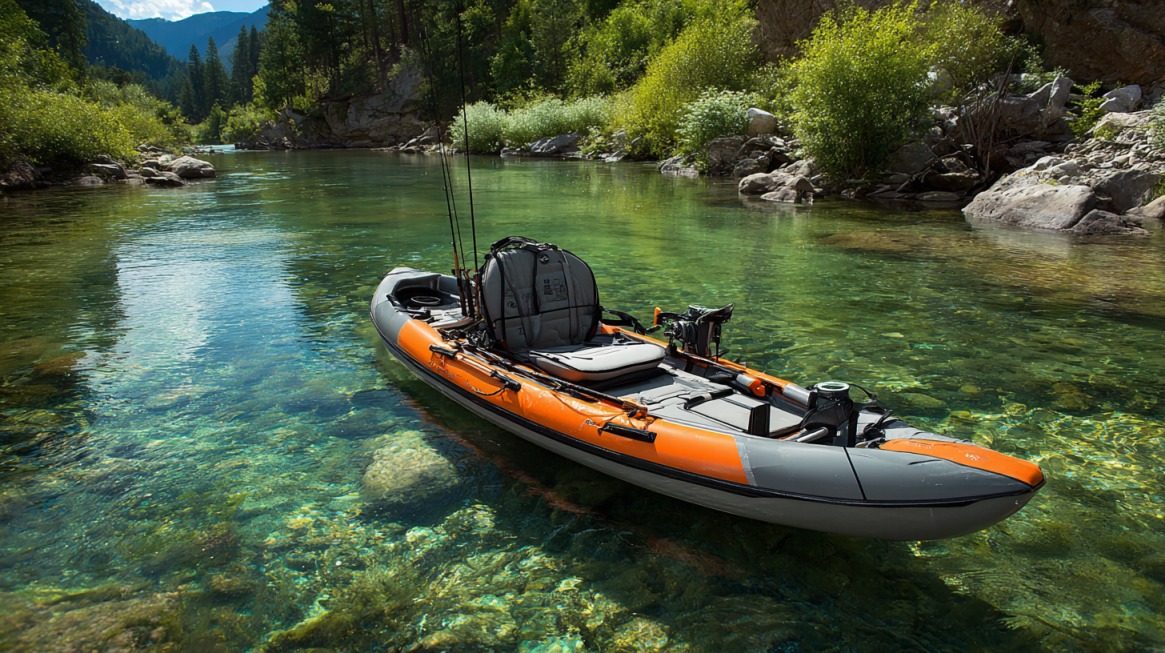
For anglers seeking flexibility and convenience, inflatable fishing kayaks have become an attractive option for lake fishing. These kayaks offer a unique blend of portability, performance, and affordability, making them an excellent choice for those who want to explore various fishing spots without the hassle of transporting a rigid kayak.
Inflatable fishing kayaks are designed to provide a stable and comfortable fishing experience. They are made with durable materials that can withstand the rigors of frequent use and harsh weather conditions.
Sea Eagle FastTrack Angler
The Sea Eagle FastTrack Angler is a top contender in the inflatable fishing kayak market, known for its durability and performance. It features multiple rod holders and a storage tank for gear, making it an excellent choice for serious anglers.
Wilderness Systems iA.T.A.K.110
The Wilderness Systems iA.T.A.K.110 brings the renowned A.T.A.K. design to the inflatable market, offering premium features in a highly portable package. Its patented “fishbone” internal structure provides exceptional rigidity and performance, similar to a hard-shell kayak.
- The iA.T.A.K.110 offers outstanding stability, allowing for comfortable seated fishing and cautious standing in calm conditions.
- It includes aluminum accessory rails and integrated Scotty mounts for adding rod holders, electronics, and other accessories.
- Weighing 50 pounds, it packs into an included backpack, making it ideal for anglers with limited storage or those who hike to remote lakes.
Tandem Fishing Kayaks for Shared Lake Adventures
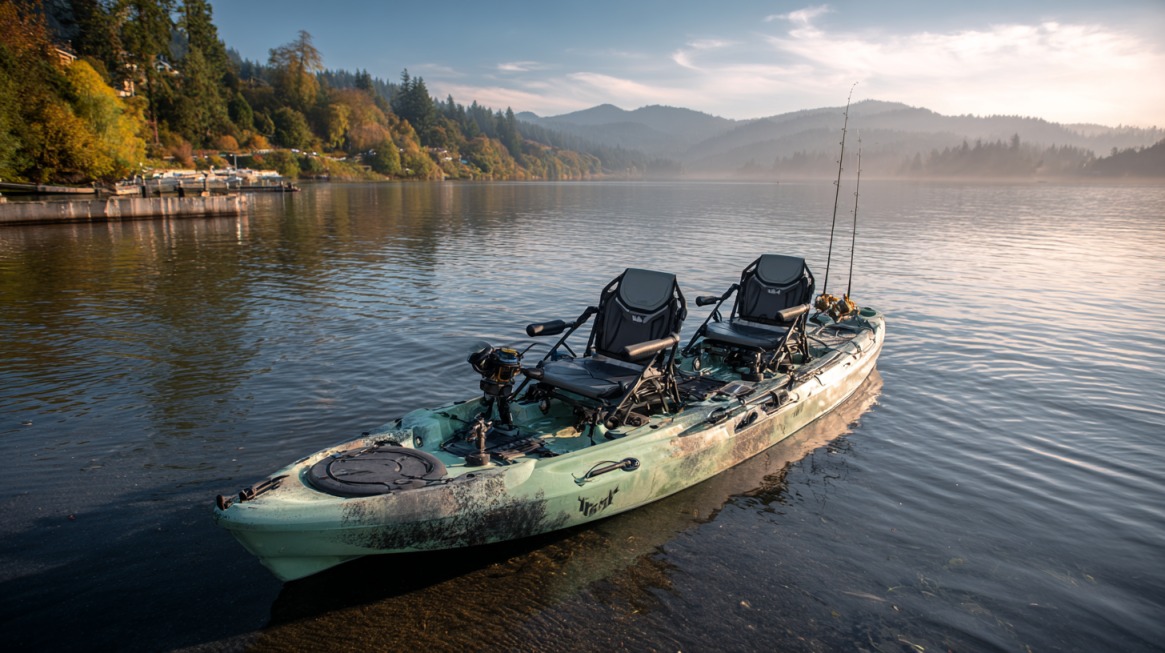
For those who love fishing with a companion, tandem fishing kayaks are an excellent choice for lake excursions. These kayaks are designed to accommodate two anglers, providing a shared experience on the water.
Feelfree Lure II Tandem
The Feelfree Lure II Tandem is a versatile kayak designed for both novice and experienced anglers. It features adjustable seats and ample storage for gear, making it suitable for long fishing trips on lakes.
Native Ultimate FX Tandem15
The Native Ultimate FX Tandem15 is a hybrid canoe/kayak that offers exceptional versatility for both solo and tandem fishing on lakes. Its design allows for easy conversion between tandem and solo configurations, making it a practical choice for different fishing needs.
- The Ultimate FX Tandem features a hybrid canoe/kayak design that provides exceptional versatility for both solo and tandem fishing on lakes and other calm waters.
- At 15’3″ long with a 600-pound capacity, it offers substantial space and weight capacity for two anglers and extensive gear.
- The open deck design provides unrestricted movement and ample storage space, while the hybrid hull offers good tracking and stability.
- The high/low adjustable seats provide comfort options for different fishing styles and conditions.
Tandem fishing kayaks like the Feelfree Lure II Tandem and Native Ultimate FX Tandem15 enhance the fishing experience by allowing anglers to share the adventure. When choosing a tandem kayak, consider factors such as seat adjustability, storage capacity, and stability to ensure a comfortable and enjoyable experience on the lake.
Essential Accessories for Lake Fishing Kayaks
View this post on Instagram
To maximize your lake fishing potential, it’s crucial to equip your kayak with essential accessories. These additions can significantly enhance your fishing experience by improving safety, comfort, and overall success on the water.
Fish Finders and Electronics
Fish finders and other electronic devices are vital for locating fish and understanding the underwater environment of the lake.
The Old Town Sportsman AutoPilot, for instance, leverages Minn Kota’s Spot-Lock technology, allowing anglers to reach their fishing spot quickly and maintain their position.
Anchoring Systems
An effective anchoring system is crucial for maintaining your position on the lake, especially in windy or current-driven conditions. A good anchor system allows you to focus on fishing rather than constantly adjusting your position.
Safety Equipment
Safety should always be the top priority when engaging in lake fishing. Essential safety items include a properly fitted personal flotation device (PFD) designed for fishing, visibility tools like flags and reflective tape, and a reliable waterproof communication device.
- A properly fitted PFD designed specifically for fishing offers freedom of movement and crucial buoyancy.
- Visibility tools such as flags on tall poles and reflective tape on paddles and hulls help make kayak anglers visible to other boaters.
- A waterproof communication device, like a marine radio or waterproof phone case, provides emergency contact capability.
Maintenance and Care for Your Fishing Kayak
Maintaining your fishing kayak properly can significantly enhance its durability and performance. Regular maintenance not only extends the life of your kayak but also ensures it remains in good condition for years to come. A well-cared-for kayak is essential for a successful and enjoyable fishing experience on the water.
Cleaning and Storage Best Practices
To keep your fishing kayak in top condition, it’s crucial to follow proper cleaning and storage practices. After each use, rinse your kayak with fresh water to remove dirt, salt, or other contaminants that could damage the material over time.
Regular inspection of your kayak’s hull for scratches, gouges, or cracks is also vital, allowing for early repair using manufacturer-recommended materials before damage worsens or affects performance.
- Rinse your kayak with fresh water after each use.
- Regularly inspect the hull for any signs of damage.
- Use manufacturer-recommended materials for repairs.
When storing your kayak, ensure it is dry and protected from direct sunlight, which can cause degradation of the materials. Proper storage will help maintain the integrity and appearance of your fishing kayak.
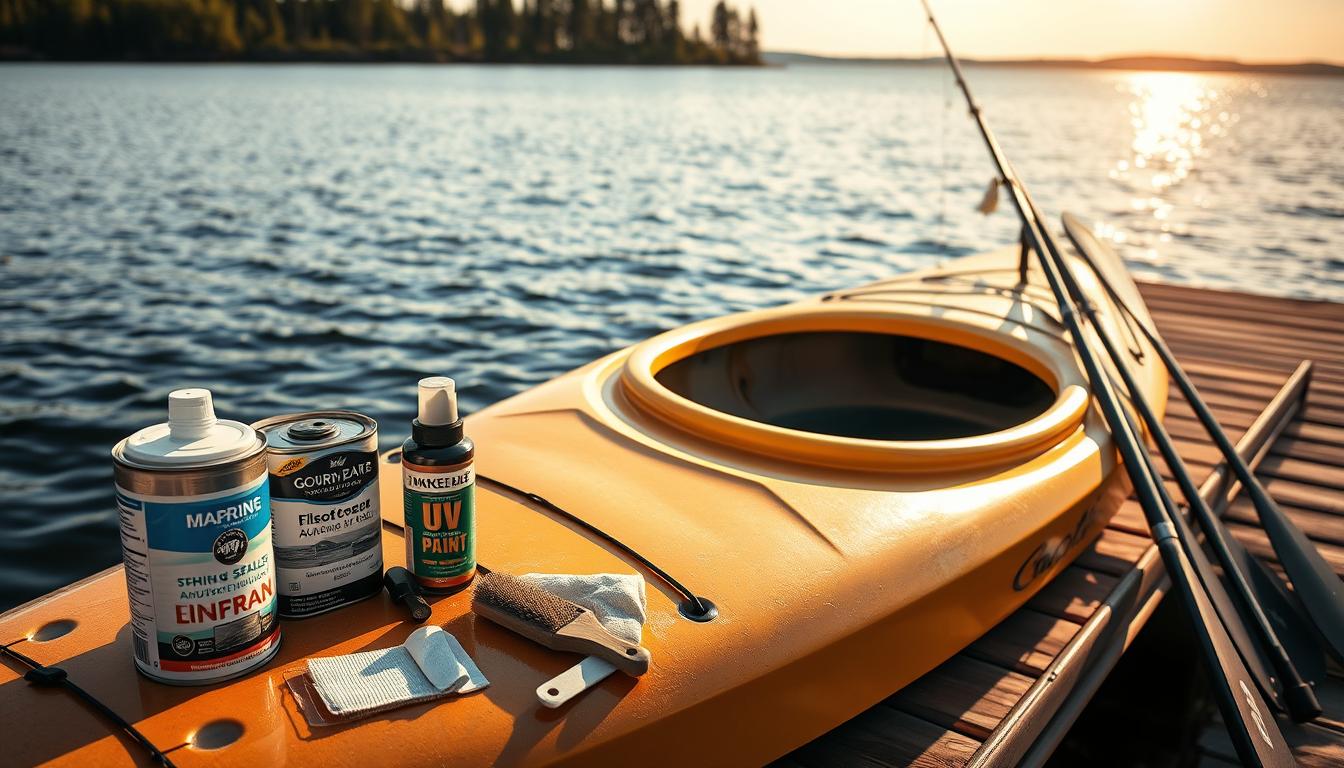
Repairs and Maintenance Tips
Regular maintenance is key to ensuring your fishing kayak remains in good working order. Pedal drive systems, for instance, require specific maintenance, including rinsing after use, periodic lubrication of moving parts, and inspection for wear on cables, chains, or drive components.
So, hardware such as screws, bolts, and rivets should be checked regularly for tightness and corrosion, with replacements made using marine-grade components to prevent failure on the water.
- Maintain your pedal drive system by rinsing and lubricating it regularly.
- Check hardware for tightness and corrosion.
- Perform regular maintenance on the rudder and steering systems.
Seat maintenance is also important, including cleaning fabric, tightening hardware, and lubricating adjustment mechanisms to extend comfort and prevent costly replacements over the years of ownership. By following these tips, you can ensure your fishing kayak remains a reliable and enjoyable platform for your fishing adventures.
Conclusion: Making Your Final Decision
Selecting the ideal fishing kayak for lake use means balancing performance, comfort, and practicality. With options ranging from rotomolded to inflatable and hybrid models, there’s a kayak to match every angler’s style and water conditions.
Focus on key factors like lake size, typical weather, launch distance, and your fishing approach. Consider not just the kayak’s features but also long-term needs—storage, transport, accessories, and upgrades.
Whenever possible, test before you buy. Hands-on experience often reveals what specs and reviews can’t. In the end, the best kayak is the one that gets you on the water regularly. Choose one that fits your lifestyle as well as your fishing goals, and you’ll enjoy years of rewarding lake adventures.

